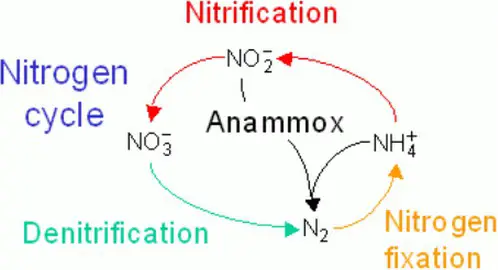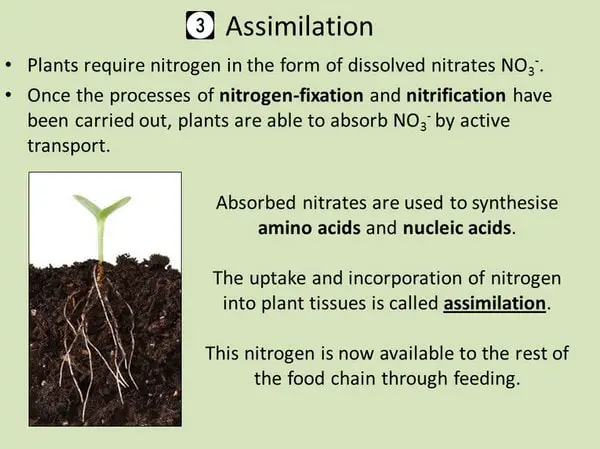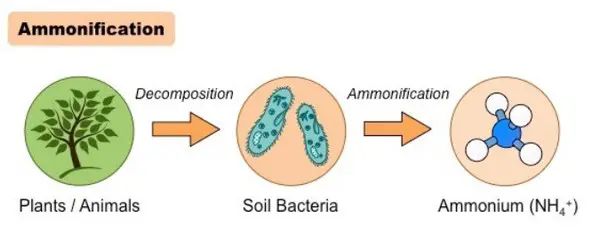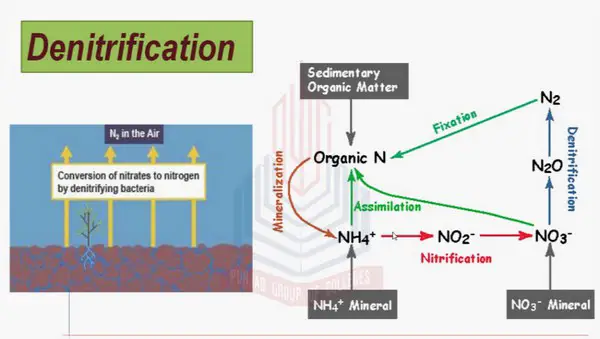Nitrogen is the building block of protein and nucleic acids. It is an integral part of all life forms. Nitrogen is abundant in the atmosphere. For it to be used in various biological processes, it needs to be converted from inert atmospheric molecule to a useful form.
The process by which nitrogen is converted from atmospheric molecular form to a form useful to living things is called the nitrogen cycle.

Image 1: The image above shows how a nitrogen cycle takes place.
Picture Source: kastatic.org
What are the stages of the nitrogen cycle?

Image 2: Nitrogen fixation is the first phase of the nitrogen cycle.
Picture Source: wikimedia.org
- Fixation – The nitrogen in the atmosphere is in the inert form and only a few organisms can benefit from it. For it to be useful to all life forms, it should be converted to fixed or organic form. Hence, the process is called nitrogen fixation. The process of nitrogen fixation includes the following:
- Nitrogen is deposited through precipitation. It comes from the atmosphere and deposited into the soil and water surface.
- Once a deposit is successful, nitrogen will have some changes. The two nitrogen atoms separate and form into ammonia by combining with hydrogen. There are three organisms responsible for this action – algae, free anaerobic bacteria, and bacteria residing in a symbiotic relationship with some types of plants. (1, 2, 3, and 4)
What to keep in mind?
- Plants do not have the ability to use atmospheric nitrogen. They need the help of nitrogen-fixing bacteria.
- Nitrogen depletion in soils is remedied by planting crops like beans and alfalfa.
- Nitrogen can be fixed through man-made processes such as the creation of nitrogen and ammonia fertilizers. (2, 3, and 4)
What are the microorganisms that play a role in the nitrogen fixation process?
- Prokaryotes
- Abiotic means such as lightning or some industrial interventions like combustion of fossil fuels.
- Root exudates from legume plants such as clover, peas, and soybeans
- Aerobic and anaerobic nitrogen-fixing bacteria
- Phototrophic and chemotrophic bacteria (4, 5)

Image 3: The nitrification process of the nitrogen cycle.
Picture Source: birmingham.ac.uk
2. Nitrification – Some plants used ammonia. However, most of the nitrogen absorbed by plants is converted from ammonia to nitrite and into nitrate with the help of some types of bacteria, which is called nitrifying bacteria. Examples are:
- Nitrosomonas
- Nitrosospira
- Nitrospira
- Nitrosococcus
- Nitrobacter
- Nitrospina
- Nitrococcus (4, 5, and 6)

Image 4: The assimilation process which is the third phase of the nitrogen cycle.
Picture Source: slideplayer.com
3. Assimilation – In this phase, various forms of nitrogen are taken up from the soil by the plants. They will be used to form plants and animal proteins.

Image 5: The image above shows how ammonification takes place.
Picture Source: bioninja.com.au
4. Ammonification – Once the plants and animals degrade or emit wastes, the nitrogen reenters the soil and decomposers will break it down. The decomposition process leads to the production of ammonia, which will be used for other biological processes. (4, 5)

Image 6: The denitrification process, which is the final step in the nitrogen cycle.
Picture Source: ytimg.com
5. Denitrification – In this phase, nitrogen goes back to the atmosphere. The nitrate form is converted back to gaseous nitrogen. The denitrification phase takes place in wet soils wherein it is impossible for microorganisms to access oxygen.
Denitrifying bacteria are the ones responsible for processing nitrate to access oxygen enabling nitrogen gas as the byproduct of the process. Microorganisms that play an important role in denitrification are:
- Bacillus
- Pseudomonas
- Paracoccus (5, 6)
What are two ways humans impact the nitrogen cycle?
Humans have a great impact on the nitrogen cycle. Humans cannot biologically fix nitrogen, but they can do so the industrial way.
Don’t you know that around 450 million metric tons of fixed nitrogen are generated every year using the Haber-Bosch process? On the other hand, there are two ways humans impact the nitrogen cycle. These are the following:
- Combustion of fossil fuels
- Use of nitrogen-containing fertilizer in the field of agriculture (5, 6, and 7)
What are the dangers of too much nitrogen?
- Too much nitrogen in the atmosphere leads to the production of acid rain.
- It also contributes to the greenhouse effect.
- When artificial fertilizers are used such as the ones containing phosphorus and nitrogen, the excess fertilizer can be washed into the bodies of water such as the streams, rivers, and lakes.
- This leads to fertilizer runoff leading to eutrophication. It is a process by which nutrient runoff leads to the overgrowth of algae and other types of microorganisms.
- The process of eutrophication reduces the availability of oxygen in the water, especially at night.
- During such time, algae and other microorganisms that feed on them take up a huge quantity of oxygen during cellular respiration.
- The end result is the death of organisms that reside in the affected ecosystem such as the shrimps and fish. (5, 6, 7, and 8)
Facts about nitrogen
- About 78% of air is nitrogen.
- Nitrogen plays a significant role in the functions of nucleic acids and amino acid.
- Nitrogen is a part of ATP, which is the primary energy molecule for living organisms.
- Living things cannot directly obtain nitrogen from the atmosphere.
- For living things to access nitrogen, nitrogen has to go through a process called nitrogen fixation.
- For nitrogen fixation to takes place, it needs the help of legumes and symbiotic bacteria or also known as nitrogen-fixing bacteria.
- Nitrogen-fixing bacteria converts nitrogen in the soil to ammonia. That way, it can be used by plants.
- Once nitrogen is fixed, it will be converted to nitrate by other bacteria through the process of nitrification.
- The final step of the nitrogen cycle is denitrification wherein nitrates in the soil are broken down and nitrogen is finally released in the atmosphere – completing the nitrogen cycle.
- Nitrogen is one of the components of many explosives.
- Nitrogen is colorless, tasteless, and odorless.
- Around 3% of the human body weight is made up of nitrogen. (2, 5, 8, 9, and 10)
References
- https://enviroliteracy.org/air-climate-weather/biogeochemical-cycles/nitrogen-cycle/
- https://en.wikipedia.org/wiki/Nitrogen_cycle
- https://www.visionlearning.com/en/library/Earth-Science/6/The-Nitrogen-Cycle/98
- https://www.khanacademy.org/science/biology/ecology/biogeochemical-cycles/a/the-nitrogen-cycle
- https://www.nature.com/scitable/knowledge/library/the-nitrogen-cycle-processes-players-and-human-15644632
- https://www.ducksters.com/science/ecosystems/nitrogen_cycle.php
- https://www.toppr.com/guides/biology/microorganisms/nitrogen-cycle/
- https://extension2.missouri.edu/wq252
- https://microbiologyonline.org/about-microbiology/microbes-and-the-outdoors/nitrogen-cycle
- https://microbiologysociety.org/resource_library/knowledge-search/schoolzone-the-nitrogen-cycle.html
